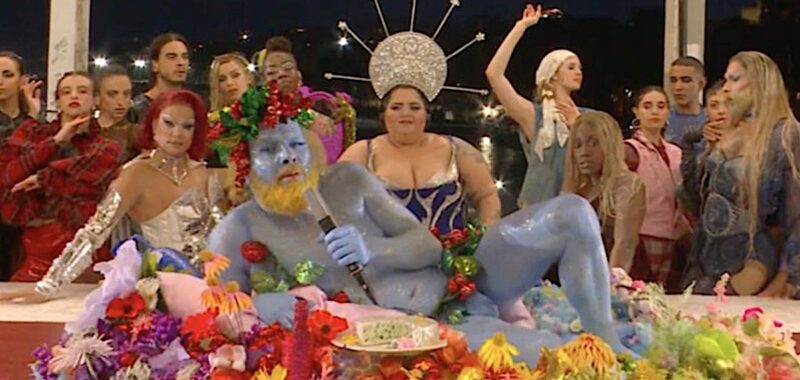
A depiction of Greek gods partying atop Mount Olympus at the Olympics opening ceremony spurred conflicting public reactions as primarily conservative critics erroneously claimed that the performance parodied Leonard da Vinci’s famous fresco “The Last Supper” (1495–98) and, by extension, mocked Christian beliefs.
The scene, the Olympics ceremony’s artistic team made clear, was not inspired by Leonardo’s rendering of Jesus Christ and the Twelve Apostles, but rather the separate, and perhaps equally iconic, art historical theme of godly festivities.
In the artistic reenactment during the Paris inauguration on Friday, July 26, a cast of drag artists, dancers, and other performers dressed in elaborate costumes referencing Greek mythology gathered around a long platform on the Debilly Footbridge. A massive dinner platter was lifted to reveal a blue-skinned, scantily clad Bacchus, portrayed by French actor and singer Philippe Katerine.
“First and foremost … [Bacchus] is the god of celebration in Greek mythology and the tableau is called ‘Festivity,’” Olympics ceremony Artistic Director Thomas Jolly said. “He is also the god of wine, which is also one of the jewels of France, and the father of Séquana, the goddess of the river Seine … The idea was to depict a big pagan celebration, linked to the gods of Olympus, and thus the Olympics.”

Bacchus and scenes of godly excess appear extensively throughout Western art history, especially during the 16th and 17th centuries. In an X thread that has garnered upwards of 1.1 million views since it was posted yesterday, one historian cited Dutch artist Jan Harmensz van Biljert’s painting “The Feast of Gods” (c. 1635–40), held at the Musée Magnin in Dijon, France. The painting depicts an assemblage of gods at a celebratory banquet on Mount Olympus commemorating the marriage of Argonaut warrior Peleus and sea nymph Thetis. In the foreground, Bacchus is shown lying on the ground, dangling a throng of grapes over his mouth while a satyr dances on the table.

This feast is notable in that it helps set the stage for the Trojan War when one uninvited guest Eris throws a golden apple, sending Hera, Athena, and Aphrodite into a vanity-fueled competition.
“The ‘Feast of the Gods’ is a common theme in the paintings of this period, and similar representations can doubtless be found in works by other painters,” a representative for the Musée Magnin told Hyperallergic in an email. The museum has used the spotlight as an opportunity to bring in audiences, sharing the reference to the artwork on X.
Among the countless similar renderings across the centuries is Dutch Mannerist painter Joachim Wtewael’s “A Banquet of the Gods,” in which a drunken Bacchus is shown in the bottom hoisting a red jug to his mouth while surrounded by cavorting gods. Other works, such as Diego Velázquez’s “The Triumph of Bacchus” (1628–29), Giovanni Bellini and Titian’s “The Feast of the Gods” (1514/29), and Jan Brueghel the Younger’s “The Feast of Bacchus” (1640) depict the Roman god similarly, wearing lush laurel wreaths with a glass of wine in hand.

Coincidentally, the opening ceremony performance is not the only incident involving Bacchus to make global headlines in recent weeks. In Italy, Florence officials are still on the hunt for one presumed tourist caught getting up close and personal with a statue of the Roman god.


